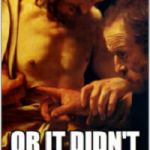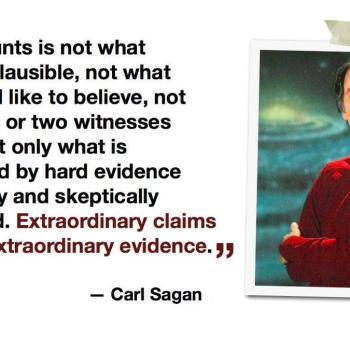It has been interesting to revisit the death of Jesus in my historical Jesus class this year. I’ve passed through phases of naive credulity and extreme skepticism with respect to the Gospels and other early Christian sources, and am now trying to find a place of balance between the two. On the one hand, there is no escaping the difficulties created by the overlay of later Christian theological interpretation on the stories, as Christians sought to make sense of the crucifixion of the one they believed to be the Messiah. On the other hand, we don’t for the most part get a depiction of Jesus walking around talking as though his only reason for being there is to die a death that will accomplish certain things, in a certain way, that is spelled out explicitly and specifically.
Indeed, there are details such as the Garden of Gethsemane narrative which suggest that Jesus had a sense that he was about to undergo something very difficult. In light of the later Christian view that Jesus’ death was an atoning sacrifice, this story is awkward and difficult, as Jesus asks to get out of it. But if he understood his path to installation as king to involve rejection and perhaps even death (following in the footsteps of his mentor John, assuming that John was executed before Jesus, contrary to the impression given by Josephus), with the dawn of the kingdom involving his resurrection not as a unique event but as part of the general resurrection, what we see fits well.
It is striking to turn in light of this to Philippians 2:6-11. If Paul is there quoting a hymn, then this might be our earliest source of information about the death of Jesus, as well as about how Christians understood it. In that passage, Jesus’ death is nothing else but the culmination of his obedience, leading to his exaltation.
Skepticism about the Jesus material can take one of two forms. On the one hand, one can say that all material interpreting the death of Jesus is written after the event. But for that to be plausible, it must be entirely the post-Easter experiences of early Christians that account for their becoming convinced that he was the Davidic anointed one despite his crucifixion. On the other hand, skeptical historians have often felt that believing Jesus to have interpreted his death in advance could seem to be making room for predictive prophecy. But there is no need to invoke prophecy or other supernatural things in order for Jesus to have seen his death coming, and having done so, to have offered an interpretation of it in relation to the soon-to-dawn kingdom of God. And this approach requires the historian to make less room for powerful religious experiences as the sole relevant factor. From this perspective, Jesus speaking about his death in advance is one of the factors that explains how Jesus’ followers could continue after his crucifixion while other messianic movements died out quickly after the execution of their central figure.
One may be skeptical of whether Jesus spoke about his death in advance. Or one may be skeptical of the capacity of religious experiences to turn a failed messiah into one vindicated by God. Neither seems inherently more preferable or more critical than the other.












